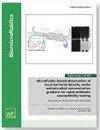微颗粒的同步振荡电惯性聚焦
IF 2.4
4区 工程技术
Q2 BIOCHEMICAL RESEARCH METHODS
引用次数: 0
摘要
本文介绍了在微流控装置中使用同步振荡压力驱动流和振荡电场对 1μm 聚苯乙烯颗粒悬浮液进行聚焦的结果。研究了振荡场之间的相位差对聚焦位置和聚焦效率的影响。带负电的聚苯乙烯颗粒的聚焦位置可在通道中心线到通道壁之间的任何位置进行调整。同样,在粒子雷诺数为 O(10-4)数量级时,聚焦效率可从 20% 到 90% 不等,这取决于相位差。测量了迁移速度曲线,发现峰值速度与振荡压力驱动的流动振幅和振荡电场振幅成线性比例。此外,还观察到平均迁移速度与电场相位差的余弦成正比,这表明了这一现象的非线性耦合性质。最后,测量了不同颗粒半径的峰值迁移速度,发现两者之间存在反比关系,即在相同条件下,迁移速度随颗粒半径的减小而增加。本文章由计算机程序翻译,如有差异,请以英文原文为准。
Synchronous oscillatory electro-inertial focusing of microparticles
Here, results are presented on the focusing of 1μm polystyrene particle suspensions using a synchronous oscillatory pressure-driven flow and oscillatory electric field in a microfluidic device. The effect of the phase difference between the oscillatory fields on the focusing position and focusing efficiency was investigated. The focusing position of negatively charged polystyrene particles could be tuned anywhere between the channel centerline to the channel walls. Similarly, the focusing efficiency could range from 20% up to 90%, depending on the phase difference, for particle Reynolds numbers of order O(10−4). The migration velocity profile was measured and the peak velocity was found to scale linearly with both the oscillatory pressure-driven flow amplitude and the oscillatory electric field amplitude. Furthermore, the average migration velocity was observed to scale with the cosine of the phase difference between the fields, indicating the coupled non-linear nature of the phenomenon. Last, the peak migration velocity was measured for different particle radii and found to have an inverse relation, where the velocity increased with decreasing particle radius for identical conditions.
求助全文
通过发布文献求助,成功后即可免费获取论文全文。
去求助
来源期刊

Biomicrofluidics
生物-纳米科技
CiteScore
5.80
自引率
3.10%
发文量
68
审稿时长
1.3 months
期刊介绍:
Biomicrofluidics (BMF) is an online-only journal published by AIP Publishing to rapidly disseminate research in fundamental physicochemical mechanisms associated with microfluidic and nanofluidic phenomena. BMF also publishes research in unique microfluidic and nanofluidic techniques for diagnostic, medical, biological, pharmaceutical, environmental, and chemical applications.
BMF offers quick publication, multimedia capability, and worldwide circulation among academic, national, and industrial laboratories. With a primary focus on high-quality original research articles, BMF also organizes special sections that help explain and define specific challenges unique to the interdisciplinary field of biomicrofluidics.
Microfluidic and nanofluidic actuation (electrokinetics, acoustofluidics, optofluidics, capillary)
Liquid Biopsy (microRNA profiling, circulating tumor cell isolation, exosome isolation, circulating tumor DNA quantification)
Cell sorting, manipulation, and transfection (di/electrophoresis, magnetic beads, optical traps, electroporation)
Molecular Separation and Concentration (isotachophoresis, concentration polarization, di/electrophoresis, magnetic beads, nanoparticles)
Cell culture and analysis(single cell assays, stimuli response, stem cell transfection)
Genomic and proteomic analysis (rapid gene sequencing, DNA/protein/carbohydrate arrays)
Biosensors (immuno-assay, nucleic acid fluorescent assay, colorimetric assay, enzyme amplification, plasmonic and Raman nano-reporter, molecular beacon, FRET, aptamer, nanopore, optical fibers)
Biophysical transport and characterization (DNA, single protein, ion channel and membrane dynamics, cell motility and communication mechanisms, electrophysiology, patch clamping). Etc...
 求助内容:
求助内容: 应助结果提醒方式:
应助结果提醒方式:


